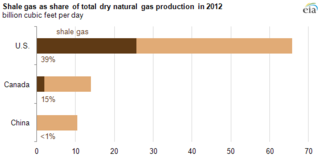
Natural gas is a naturally occurring hydrocarbon gas mixture consisting primarily of methane, but commonly including varying amounts of other higher alkanes, and sometimes a small percentage of carbon dioxide, nitrogen, hydrogen sulfide, or helium. It is formed when layers of decomposing plant and animal matter are exposed to intense heat and pressure under the surface of the Earth over millions of years. The energy that the plants originally obtained from the sun is stored in the form of chemical bonds in the gas.

Hydraulic fracturing in the United States began in 1949. According to the Department of Energy (DOE), by 2013 at least two million oil and gas wells in the US had been hydraulically fractured, and that of new wells being drilled, up to 95% are hydraulically fractured. The output from these wells makes up 43% of the oil production and 67% of the natural gas production in the United States. Environmental safety and health concerns about hydraulic fracturing emerged in the 1980s, and are still being debated at the state and federal levels.

Westby-with-Plumptons is a civil parish in Lancashire, England. The parish is in Fylde district and contains the hamlets of Great Plumpton, Little Plumpton, Lower Ballam, Higher Ballam, Moss Side, Peel, and Westby. At the 2011 census, the parish had a population of 1,205. Westby and Plumpton are mentioned in the Domesday Book, as "Westbi" and "Pluntun".

Hydraulic fracturing is a well stimulation technique in which rock is fractured by a pressurized liquid. The process involves the high-pressure injection of 'fracking fluid' into a wellbore to create cracks in the deep-rock formations through which natural gas, petroleum, and brine will flow more freely. When the hydraulic pressure is removed from the well, small grains of hydraulic fracturing proppants hold the fractures open.

Hydraulic fracturing in the United Kingdom started in the late 1970s with fracturing of the conventional oil and gas fields of the North Sea. It has been used in about 200 British onshore oil and gas wells since the early 1980s. The technique did not attract attention until licences use were awarded for onshore shale gas exploration in 2008.

Hydraulic fracturing (fracking) has been carried out in New Zealand for over 27 years, mostly in Taranaki and also in coal seams in Waikato and Southland. Concerns have been raised about its negative effects and some local government jurisdictions have called for a moratorium on fracking but this has been rejected by the government. The environmental effects of fracking are regulated by the Resource Management Act (RMA) through the requirement for resource consents.

Hydraulic fracturing has become a contentious environmental and health issue with Tunisia and France banning the practice and a de facto moratorium in place in Quebec (Canada), and some of the states of the US.

Environmental impact of hydraulic fracturing in the United States has been an issue of public concern, and includes the potential contamination of ground and surface water, methane emissions, air pollution, migration of gases and hydraulic fracturing chemicals and radionuclides to the surface, the potential mishandling of solid waste, drill cuttings, increased seismicity and associated effects on human and ecosystem health. A number of instances with groundwater contamination have been documented, however opponents of water safety regulation claim hydraulic fracturing has never caused any drinking water contamination.

The environmental impact of hydraulic fracturing is related to land use and water consumption, air emissions, including methane emissions, brine and fracturing fluid leakage, water contamination, noise pollution, and health. Water and air pollution are the biggest risks to human health from hydraulic fracturing. Research is underway to determine if human health has been affected, and adherence to regulation and safety procedures is required to avoid negative impacts.
Refracktion is a British group concerned with the environmental impact of hydraulic fracturing (fracking) for gas on the Fylde Coast of Lancashire, England. They believe fracking will have inevitable negative effects on the local environment and its amenity value.
An anti-fracking movement has emerged both internationally, with involvement of international environmental organizations and nation states such as France, and locally in affected areas such as Balcombe in Sussex, Pungești in Romania and In Salah in Algeria.
Shale gas in the United Kingdom has attracted increasing attention since 2007, when onshore shale gas production was proposed. The first shale gas well in England was drilled in 1875. A number of wells have been drilled, and favourable tax treatment has been offered to shale gas producers.

The Marcellus is a large and prolific area of shale gas extraction from the Marcellus Formation of Devonian age in the eastern United States. The shale play encompasses 104,000 square miles and stretches across Pennsylvania and West Virginia, and into eastern Ohio and western New York. It is the largest source of natural gas in the United States, and production was still growing rapidly in 2013. The natural gas is trapped in low-permeability shale, and requires the well completion method of hydraulic fracturing to allow the gas to flow to the well bore. The surge in drilling activity in the Marcellus Shale since 2008 has generated both economic benefits and considerable controversy.

Hydraulic fracturing in South Africa is an energy production strategy in early stages of development using high-pressure drilling techniques to release natural gas trapped in shale rock. After initially imposing a moratorium on hydraulic fracturing in April 2011, the South African government lifted the moratorium in September 2012 after an initial investigation by an interdepartmental task team. Several energy companies were subsequently granted exploration licenses. Fracking in South Africa is a current topic of debate, with proponents pointing to substantial economic and energy benefits and opponents voicing concerns about potentially adverse environmental impacts.
This article will be discussing the rules and regulation of shale gas. There are going to be four major topics that surround the issues of the rules and regulations regarding shale gas. Safeguards and loopholes, environmental assessments, monitoring and mitigating, and Canadian deregulation and international governance. These four issues will be the main focus of the article

Countries using or considering to use hydraulic fracturing have implemented different regulations, including developing federal and regional legislation, and local zoning limitations. In 2011, after public pressure France became the first nation to ban hydraulic fracturing, based on the precautionary principle as well as the principal of preventive and corrective action of environmental hazards. The ban was upheld by an October 2013 ruling of the Constitutional Council. Some other countries have placed a temporary moratorium on the practice. Countries like the United Kingdom and South Africa, have lifted their bans, choosing to focus on regulation instead of outright prohibition. Germany has announced draft regulations that would allow using hydraulic fracturing for the exploitation of shale gas deposits with the exception of wetland areas.











